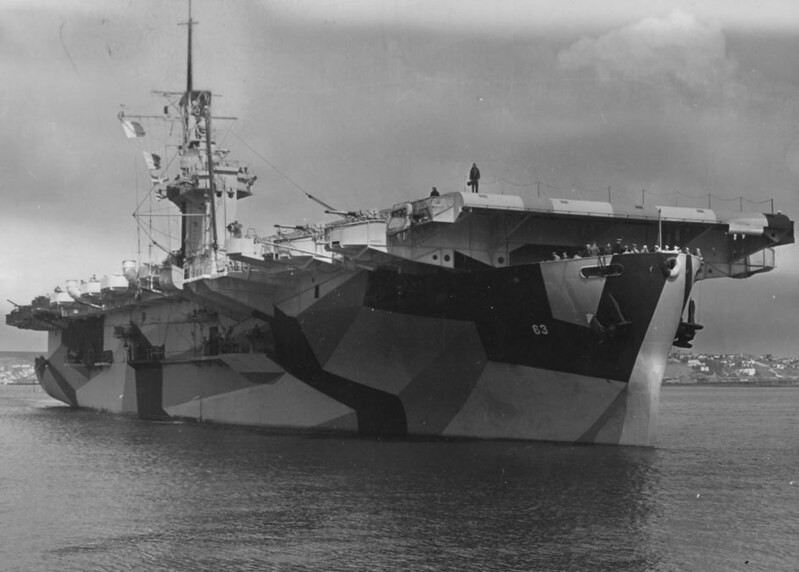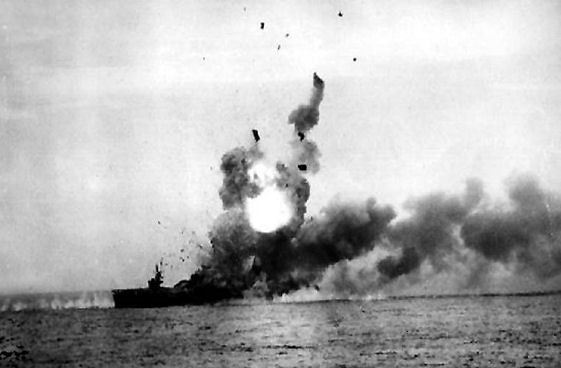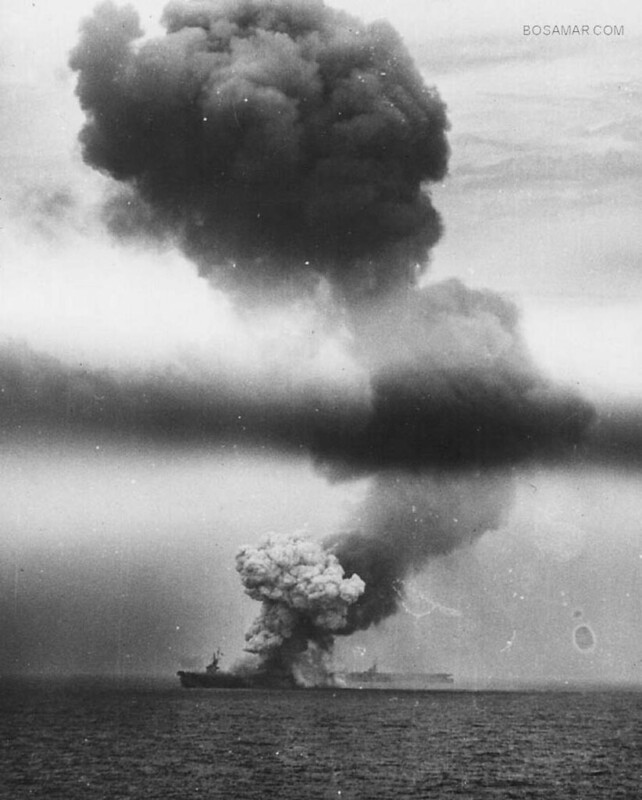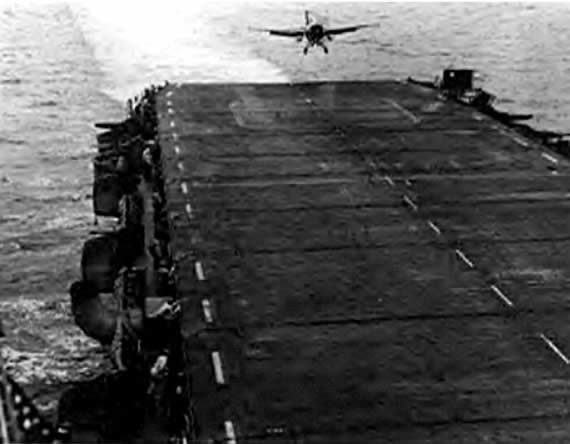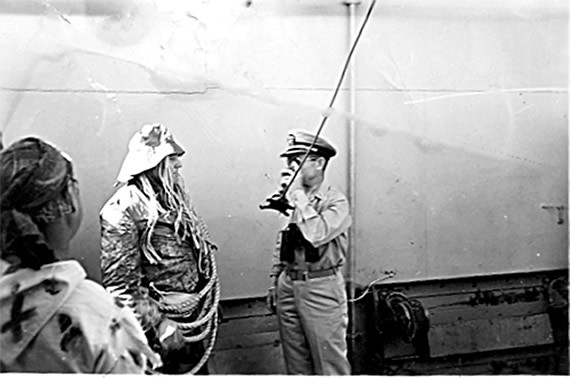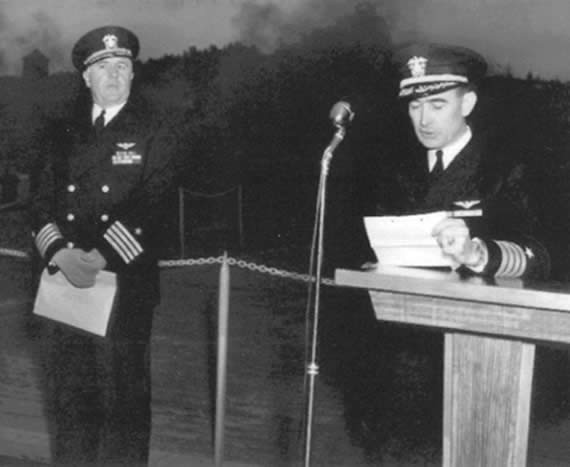Originally scheduled to be named Chapin Bay, the keel of the CVE-63 was laid on January 23, 1943, at Kaiser Shipyard in Vancouver, Washington. It was launched on August 17, 1943, and commissioned on October 23, 1943, at Astoria, Oregon, with Capt. Francis J. McKenna in command.
USS St. Lo (formerly Midway)
CVE-63/VC-65
Ninth Escort Carrier of the Casablanca class
Specifications
- Length: 512 feet
- Beam: 65 feet
- Draft: 22 feet, 6 inches
- Flight Deck: 498 X 108 feet
- Speed: 18 Knots
- Engines: Skinner Uniflow 11,200 Horsepower, Twin Screws
- Loaded displacement: 10,200 tons
Armament
- 1-5″ 38 gun
- 8-twin 40mm guns
- 20-20mm guns
Radar
- SG Surface search
- SK Air search
- YE Homing Beacon
Following a shakedown cruise, the ship made two trips to Pearl Harbor and a trip to Brisbane, Australia, transporting planes. Upon returning to our home port of San Diego, Composite Squadron 65 (VC-65) which had been in training, was received aboard and continued training.
In June 1944, the Midway joined Carrier Support Group 1 for the invasion of the Marianas (Guam, Saipan and Tinian) and the “Marianas Turkey Shoot,” a huge Japanese air attack in which many enemy planes were shot down by ship anti-aircraft fire and fighter aircraft. During this campaign, through June and July, 1944, 9 pilots and crewmen were lost to enemy action, and the ship fought off many air attacks.
After repairs and resupply, the Midway was assigned to the 7th fleet, sailed to Seeadler harbor at Manus Island in the Southwest Pacific (off New Guinea), and was soon in action again providing air cover for the invasion of Morotai in the Moluccas island group. Morotai was the closest island to the Philippines and was needed to provide land-based air cover for the coming invasion of Leyte.
During this time, a Japanese submarine fired torpedoes at the Midway. Fortunately, they missed, but tragically continued on to strike and sink the Shelton (DE 407). Again a price was paid, as one pilot and 2 crewmen were lost. Upon returning to Manus, the news was received that on October 10, 1944, the name would be changed to St. Lo to free the name of Midway for a giant new aircraft carrier CV-41, and to commemorate the victory by American forces at St. Lo in France.
Preparations were then made for the invasion of the Philippines at Leyte on October 20, 1944, and Task Group 77.4 was formed and divided into three Task Units: 77.4.1, 77.4.2 and 77.4.3, respectively code named: “Taffy 1,” Taffy 2,” and “Taffy 3.”
Taffy 3, under Admiral C.A.F. “Ziggy” Sprague, consisted of CVEs St. Lo, White Plains, Kitkun Bay, Kalinin Bay, Fanshaw Bay and Gambier Bay, escorted by the Destroyers: Heermann, Hoel and Johnston and Destroyer Escorts: Dennis, Samuel B. Roberts, John C. Butler and Raymond.
The Taffies were assigned stations from the North off Samar and extending South off Mindanao, with Taffy 3 in the northernmost position. After providing air cover for the Army on Leyte for five days, on the morning of October 25, 1944, while steaming off the island of Samar, the crew awakened to a desperate situation. Admiral Kinkaid, in command of the Seventh fleet, assumed from dispatches, that Admiral Halsey who was in command of the powerful Third Fleet intended to leave his new, fast battleships with their escorting cruisers and destroyers to guard San Bernardino Strait North of Samar. This he failed to do!!!
Following the sinking, the four remaining escort ships, Heermann (DD 532), Dennis (DE 405), John C. Butler (DE 339) and Raymond (DE 341) were directed to pick up survivors. Heermann and Dennis were severely damaged and were ordered to Kossol Passage at Palau. Butler and Raymond had suffered no damage, but were directed to Leyte Gulf. From there we were scattered to the four corners of the world, rarely to see each other until the 1980s when we began gathering at annual reunions.
Read Captain McKenna’s Action Report dondennisfamily.com
Battle Map: The Battle of Leyte Gulf dondennisfamily.com
